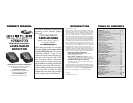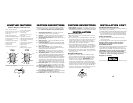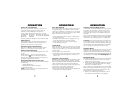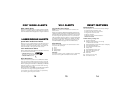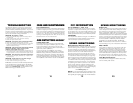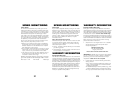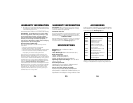
TROUBLESHOOTING
FCC INFORMATION
CARE AND MAINTENANCE
17
Your Whistler detector is expertly engineered and
designed to exacting quality standards to provide
you with reliable, trouble-free operation. If your unit
has been correctly installed following the guidelines
in this manual, but is not operating optimally, please
refer to the troubleshooting guide below.
PROBLEM: No display or audio.
• Check fuse in Whistler plug; replace if necessary with a 2
amp 3AG type.
• Check fuse for lighter socket; replace if necessary.
• Make sure lighter socket is clean.
PROBLEM: Unit alarms when vehicle hits bumps.
• Check for loose lighter socket; tighten and clean.
• Check connections at both ends of power cord. Substitute
another cord to determine if cord is defective. Return
defective cord to the factory.
PROBLEM: Unit alarms when using vehicle electrical
accessories
(brakes, power mirrors, power
windows, turn signals, horn, etc.).
• Vehicle’s electrical system, including battery and alternator, may
have electrical noise. Install a filter capacitor
(470mfd. 25 volt
or larger capacitance value)
on the back of the lighter socket.
PROBLEM: Unit gives laser alert when accelerating.
• Possible bad or low quality distributor cap. Replace with
high quality cap.
PROBLEM: Audio alerts are not loud enough.
• Cancel Auto Quiet Mode or City Mode.
• Check audio level setting
(see page 7 & 8).
If difficulties occur which cannot be solved by information
in this Troubleshooting Guide, please call Whistler
Customer Service at 1-800-531-0004 or visit our FAQ
page at www.
whistlergroup.com/faq-detectors.asp,
before returning your unit for service.
18
ARE DETECTORS LEGAL?
19
In Most States YES!
Laser-Radar detectors are legal in every state (with
the exception of Virginia and Washington, D.C., which
have local regulations restricting the use of radar
receivers in any vehicle) when used in automobiles or
light trucks (under 10,000 lbs.).
Concerning trucks over 10,000 lbs., the Federal
Highway Administration (FHWA) issued a regulation,
effective January, 1994 which prohibits radar and laser
detector use in these types of vehicles nationally. Prior
to the FHWA regulation, laws existed in the state of
New York restricting the use of radar detectors in trucks
over 18,000 lbs. and in Illinois in trucks over 26,000 lbs.
Care And Maintenance
During the summer months, avoid prolonged exposure
to direct sunlight by removing your unit from the dash
when your vehicle is parked for an extended period of
time. Do not spray water, cleaners, or polishes directly
onto the unit. The spray may penetrate through the
openings and damage the unit. Also, do not use any
abrasive cleaners on the unit’s exterior.
20
Radar Detector Detectors (VG-2)
The Interceptor VG-2, or simply VG-2, is a microwave
receiver used by police to detect signals radiated by
the local oscillator of a radar detector. Because its
purpose is to identify persons driving with radar detectors,
the VG-2 is known as a ‘radar detector detector’.
The VG-2 is the primary tool used by the police to
identify radar detector equipped vehicles. If caught,
in a state where detectors are illegal, (see page 18),
drivers risk losing their radar detector and receiving a
fine. In addition, instant-on radar is almost always used
in combination with a VG-2, leaving unsuspecting motorists
vulnerable to receiving two tickets - one potentially
for speeding, the other for possession of a detector.
Having a radar detector capable of detecting the
VG-2 may alert you to the presence of a speed trap. For
more information on speed monitoring technologies,
please visit our FAQ page on our website:
www.
whistlergroup.com
NOTE: It is the responsibility of the individual radar
detector owner to know and understand the laws in your
area regarding the legality of the use of radar detectors.
SPEED MONITORING
FCC ID HSXWH11 - 1758, 1773
This device complies with part 15 of the FCC Rules.
Operation is subject to the following two conditions:
(1) This device many not cause harmful interference, and
(2) this device must accept any interference received,
including interference that may cause undesired operation.
IMPORTANT
FCC requirements state that changes or modifications
not expressly approved by Whistler could void the
user’s authority to operate the equipment.
SPEED MONITORING
Radar Facts
A radar gun operates by transmitting radio waves at
certain frequencies which reflect off objects and are
then picked up by the radar gun’s receiving section.
When a radar beam reflects off a moving target, a
measurable frequency shift occurs. The radar unit converts
this shift into miles per hour to determine your vehicle’s
speed. Currently, the FCC (Federal Communications
Commission) permits operation of traffic radar guns
at X Band (10.500 - 10.550 GHz), K Band (24.050 -
24.250 GHz), and Ka Band (33.400 - 36.000 GHz).
Note: A radar detector will not alarm if an officer is
not transmitting on any one of the above radar bands.
POP™ Mode
POP
™
Mode is a feature on some newer radar guns
operating on K and Ka bands. When the gun is in
POP
™
Mode and activated, a brief burst of energy,
less that 1/15 of a second, is transmitted and the
vehicle’s speed is quickly acquired. A detector without
POP
™
Mode detection capability cannot respond to
this brief transmission. This detector has the power
to report this new gun where other detectors cannot!
Total Band Protection™
Complete Band Coverage that detects laser, radar,
VG-2 and safety radar bands.



